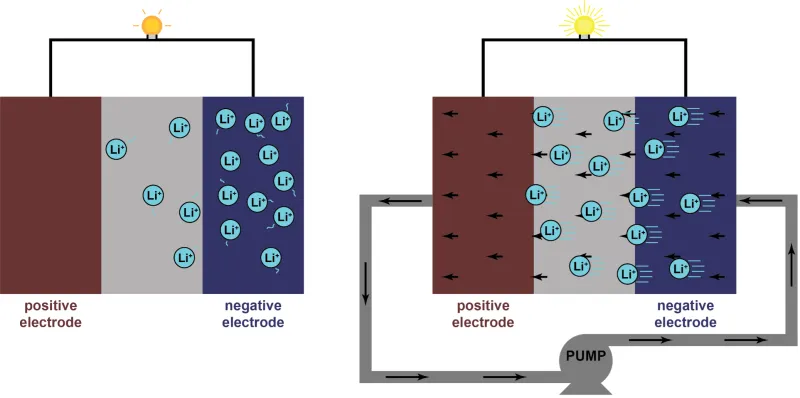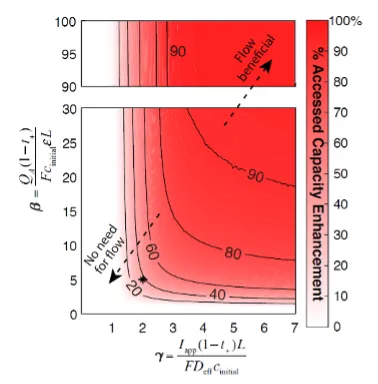Convection-Enhanced Electrochemical Energy Storage Device
Convection-enhanced electrochemical cells enable faster complete charging and discharging of high-capacity batteries. Such batteries are of great potential interest to manufacturers of electric vehicles and providers of grid-level energy storage solutions.
Researchers
-
convection-enhanced electrochemical energy storage devices and related methods
United States of America | Granted | 12,218,316
Figures
Technology
In addition to the elements of a traditional electrochemical cell, convection-enhanced electrochemical cells incorporate a mechanical pump that drives electrolyte through the electrodes and separators. Pumping electrolyte through the cell augments the rate at which ions move in the desired direction for charging and discharging, allowing the full capacity of the cell to be accessed even when the electrode materials are higher-capacity and the charging and discharging are done at higher-power. In addition to a general scheme to increase performance by pumping electrolyte, the patent application discloses a suite of analytical tools for quantitatively predicting the performance increases that can be expected from incorporating electrolyte pumping into an electrochemical energy system. These tools will enable identification of systems in which incorporation of electrolyte pumping can be expected to be economical.
Problem Addressed
A key barrier to the adoption of lithium-ion batteries in transportation is the immense difficulty of charging an electric vehicle on a timescale compatible with consumer expectations based on many years of simply pumping a few gallons of gasoline to refuel. Furthermore, the relatively slow charging has led to a preoccupation with electric vehicle range and thus a need to produce high-capacity batteries. Limitations in how quickly grid-scale energy storage batteries can safely charge similarly require more batteries to absorb the energy generated by solar when the sun is shining and wind when wind speeds are high.
All batteries fundamentally consist of two electrodes that can hold charge in the form of absorbed ions and a separator between them through which ions can pass during charging and discharging. Traditional sealed lithium-ion batteries are inherently limited in their rates of charging and discharging by the rate that lithium ions can pass between the electrodes. Attempting to force electrical energy into the battery too quickly during charging both causes charging to stop prematurely and heats up the battery, potentially leading to fire. Similarly, the voltage output of a battery will drop to zero before the electrodes are depleted of charge if too much power is demanded of the battery during discharge. These limitations arise because, under normal operation, the only means by which ions move from one electrode to another is by a random walk (passive diffusion), relying entirely on the imbalance of amounts of ions at each electrode generated by the charging or discharging reactions to produce a net current of ions. In addition to limiting charge and discharge rates, reliance on passive diffusion necessitates very thin electrodes and separators to minimize the distance that ions must wander, complicating manufacturing and reducing capacity.
Advantages
-
Improved charge/discharge capacity
-
Improved charge/discharge speed
-
Improved safety
-
Simplified manufacturing
Publications
Weiran Gao, Michael J. Orella, Thomas J. Carney, et al.Understanding the Impact of Convective Transport on Intercalation Batteries Through Dimensional Analysis. Journal of the Electrochemical Society. 2020 Nov 30. doi: 10.1149/1945-7111/abbce3
License this technology
Interested in this technology? Connect with our experienced licensing team to initiate the process.
Sign up for technology updates
Sign up now to receive the latest updates on cutting-edge technologies and innovations.

